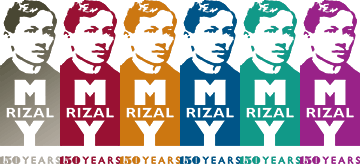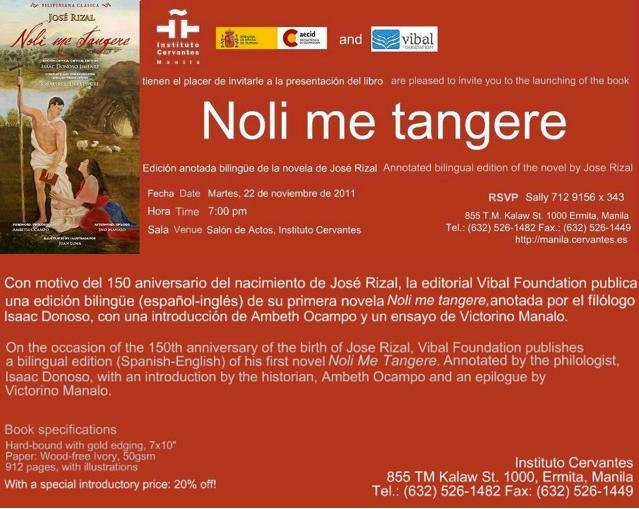MANILA, Philippines — When he first came to the Philippines from Spain, author Isaac Donoso Jimenez came looking for Jose Rizal’s famous novel, Noli Me Tangere, in its original Spanish text but he couldn’t seem to find one in any book stores in Manila.
While the National Hero’s novels – both Noli and its sequel El Filibusterismo – which had inspired the Philippine Revolutions that ended the over 300 years of Spanish rule, are requirements in schools and universities, “they are almost universally read in translation, studied in its abridged or condensed editions, or sometimes interpreted as komiks,” as how Ambeth Ocampo, former chairman of the National Historical Commission of the Philippines, puts it.
And the Spanish author was baffled. For how could it be that in the country where the great hero and writer had once lived, the same country he died for, one couldn’t find any of his original works?
Ocampo shares the same view: “The best way to read Rizal is to read his novels in the original Spanish, but copies are not readily available in bookstores and libraries. For the past 50 years, offset reprints of Rizal’s novels have been published and distributed by the National Historical Commission of the Philippines, which has continuously kept in print facsimiles of the original manuscripts and the first editions. These are readily appreciated for their antiquarian and historical interest but are difficult to read and lack detailed and updated annotations.”
That got Jimenez thinking that there was indeed a great need to create a critical edition of the novel that will result in great appreciation of Rizal’s life and works.
“[Years after Rizal’s death], all the principal intellectuals and writers… were engaged in composing pages and poems in his memory. In just a few years, his works which were practically written in secrecy began to circulate and be translated; his figure was more revered than understood. The disappearance of the Spanish, the language in which his main works were written, in the Philippines closes the circle in the process of alienation, sending his intellectual legacy into oblivion, or misinterpretation,” wrote Jimenez in the latest edition of Noli Me Tangere, which was published in collaboration with the Vibal Foundation and the Instituto Cervantes de Manila.
The historical bilingual edition, with complete and unexpurgated English translation by Charles E. Derbyshire and illustrations by painter Juan Luna, is released as part of the sesquicentennial birth anniversary of its author, Jose Rizal. It aims to restore the original Spanish text and trace its textual history.
“A critical edition is a philological intervention in order to restore the final text of a literary piece, [according to] the will of the author. The principle that has guided this edition has been to study the novel’s textual history based on the corrections made by the author himself, while at the same time regularizing it within present Spanish orthography,” shares Jimenez.
In the new book, expurgated passages have been restored, thus maintaining its fidelity to Rizal’s original text.
The textual corrections made in Rizal’s handwriting have been noted down, employing the facsimile version of the original manuscript published in Manila in 1991 by the National Historical Institute, and the digital copy scanned from the original, which is available at the National Library of the Philippines.
In his book, Jimenez describes the original manuscript, which was acquired by the Philippine government at the start of the 20th century and is preserved at the National Library: “It bears the original cover designed by the author, with the title running diagonally between Filipino designs and partially covering the dedication underneath; 233 pages are numbered until page 465; the book is bound by three strings on the outside and three on the inside; it measures 22 X 37 cms; the writing margins measure 15 x30 cms; its paper is lined in blue ink about a centimetre apart.”
He continues: “The text is in black ink, with immediate corrections in the same ink; erasures are in black, later corrections in blue; Roman numerals of the chapters are in pencil; each complete page contains 31 lines; the manuscript has regular lines and margin; the letters are rounded and clear, erasures are made with a horizontal line crossing the word and insertions between lines and on the margin are written in irregular letters.”
Using the first edition of the novel which was printed in Berlin in 1887, Jimenez undertook three philological interventions: (1) modernization of the orthography to the current norm as dictated by the Real Academia Española, (2) annotations for the time of corrections and alterations done by Rizal, and (3) explanatory notes about cultural, linguistic, social and historical context of the novel.
Jimenez shares: “Since we are not doing a palaeographical or archaeological edition, the text has to be displayed using the modern orthography of Spanish language. The first edition that modernized the orthography was the one published in Venezuela by Russoto in 1976. This edition has been followed by the three that have appeared in the last 20 years in Spain.”
For the annotations, Jimenez identified three stages in which Rizal altered the novel, making over 1000 annotation notes. “In the process of annotations, we identify three stages: one, corrections at the same time of writing; two, corrections in black and blue ink as general revision of the manuscript; and, three, changes that do not appear in the manuscript but are different in the first edition.”
Through this edition, Jimenez hopes that the Filipino people would realize that Noli Me Tangere is more than just a novel, but “the chronicle of the birth of a people, the Filipino nation.”
THINGS YOU MAY NOT KNOW ABOUT NOLI
• Noli Me Tangere is a Latin term which means “Touch Me Not.” The proper classical pronunciation is “Noli Me Tánguere,” but in 19th century, the reading became what it is now.
• The novel’s title came from the Gospel of St. John [20:17]. In his letter to painter Felix Resurreccion Hidalgo dated March 5, 1887, Rizal expounded on the title (stating erroneously that it came from the Book of St. Luke): “Noli Me Tangere, words of the Evangelist St. Luke means ‘Do not touch me.’ The book thus contains things that none of us has so far uttered: they are so sensitive that we are affected. Me, I tried to do what nobody wanted to do.”
• There are two other principles with which Rizal based the title. Firstly, he pointed out in his preface the medical concept of a sickness that is better not to touch because it would produce a haemorrhage. Secondly, he gave the sociological concept about a problem that is better not to speak about or to expose.
Ma. Glaiza Lee
Manila Bulletin Publishing Corporation

